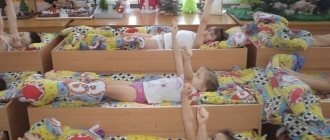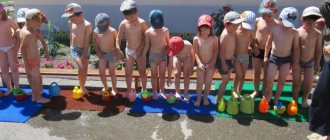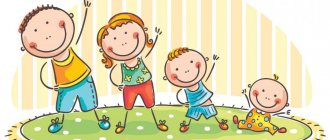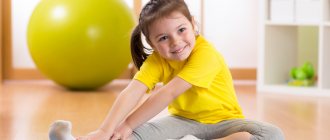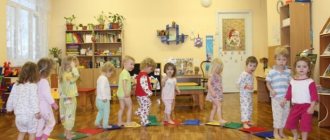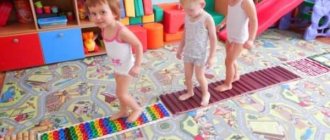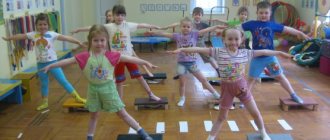Gymnastics after sleep in kindergarten: theory and practice
Natalya Vasylishin 08/31/2017 5 9.6k
Sleep plays a vital role in a child's daily routine. How the baby wakes up depends on his mood, state of health and how he will spend the rest of the day. In kindergarten, organizing a proper awakening is more difficult than for parents at home, because it is necessary for 15, 20, or even 30 people to throw off the shackles of Morpheus almost simultaneously, and to do it correctly. Solving such a problem is not easy, but with knowledge of some methodological nuances it is quite possible.
Goals, objectives and techniques
Gymnastics after sleep is a set of exercises that provide a smooth transition from calmness to wakefulness.
The objectives of such classes are:
- increase in muscle tone;
- improved mood;
- prevention of colds;
- strengthening the respiratory system;
- preventing the development of problems with posture, flat feet;
- fostering the habit of stretching the body after waking up.
Not only his mood, but also the emotional atmosphere of the entire group depends on how each child wakes up.
To achieve the goals, every day the teacher selects exercises to solve problems such as:
- toning the nervous system (that is, preventing irritability and anxiety that may arise after waking up);
- improving the functioning of the body’s main systems (cardiovascular, respiratory, as well as stabilizing the body’s protective functions);
- creating a positive atmosphere in the group.
All this is possible with the right combination of gymnastics techniques after sleep.
- The plot of the awakening. This technique is especially important for children of the first and second junior groups. The essence of the technique is that all exercises are carried out within the framework of a common plot. For example, a bear came to visit us and asked for help: her son Mishka could not wake up, and he needed to go to help his mother to pick raspberries for the winter - he needed to show by example how to quickly restore the body after sleep. In addition, it will be more interesting for children to perform certain actions accompanied by rhymes and short sayings.
- Musicality. Quiet, relaxing music, played a little louder than before bed, helps children of any age recover.
Gymnastics after waking up should be done to music
More information about gymnastics after sleep in the preparatory group can be found in our article - We conduct gymnastics after sleep in the preparatory group of the kindergarten.
Sets of exercises for the treatment and correction of foot and leg deformities
Exercises on a massage mat can help in the treatment and rehabilitation of leg diseases. We offer a set of exercises that will help cure common deformities - combined flat feet, hallux valgus and clubfoot. These exercises should not be used as an independent treatment for these diseases.
Complex for the treatment and correction of combined flat feet
This complex contains exercises affecting the transverse and longitudinal arch.
Starting position – straight back, hands on the belt.
- Walking back and forth on the massage mat – 5 minutes in each direction.
- Walking on the inside and outside of the foot - 5 minutes each.
- Smooth rolls from heel to toe – 3-6 minutes.
- Walking forward with your back - 5 minutes.
- Walking on your toes and heels – 5 minutes each.
- Stretching while standing on your toes – 3-6 minutes.
- Squatting “duck-style” walking – 3-6 minutes.
- Alternately stand on one leg - 3 minutes on each.
- Jumping with support only on your toes – 3-6 minutes.
- Walking on your toes in a cross step – 3-6 minutes.
- Walking on the inside and outside of the foot in a cross step – 3-6 minutes.
Complex for the treatment and correction of valgus feet
The complex will help correct deviation of the big toe and X-shaped curvature of the legs, which are characterized by hallux valgus.
- Walking back and forth – 5 minutes.
- Walking with high knees – 5 minutes.
- Regular walking with squats – 4 minutes.
- Step-squat – 10-15 times.
- Walking “duck style” – 5 minutes.
- Walking with support on the outer and inner sides of the foot - 5 minutes each.
- Walking with side steps in different directions - 4 minutes in each direction.
- Jumping forward and backward – 3 minutes each.
Types of gymnastics, or a little about the terms
Gymnastics after sleep in some sources is called corrective, and sometimes includes corrective in its range of types.
This is interesting. Corrective gymnastics (from the Latin corrigo - straighten, correct) is a type of therapeutic gymnastics - special exercises to eliminate postural disorders; it also has a general strengthening effect (trains the functions of the cardiovascular and respiratory systems, strengthens individual muscle groups); restores balance between the curvatures of the spine.
Based on the definition, which includes the main goals and objectives of performing exercises after sleep, we can conclude that gymnastics after sleep, invigorating and corrective are all terms of the same synonymous series. Types of corrective exercises can be:
- correctional exercises (exercises aimed at correcting some specific disorders in the functioning of the child’s body, for example, flat feet or curvature of the chest);
- hardening (except for walking, hardening is not the lot of many people, because this is a special type of health procedures, which is carried out, as a rule, in specialized groups, it includes washing with cold water, dousing on the street, etc.);
- lazy gymnastics (exercises that are performed lying down, sitting, without sudden movements of strong physical exertion);
- physical education minutes (conducted regularly during breaks during classes, so that children not only take a break, but also work to strengthen the body);
- preventive gymnastics (a universal set of exercises that is most often used in preschool institutions).
This is interesting. Preventive gymnastics is sometimes called invigorating.
Types of exercises
If we talk about corrective gymnastics after sleep, it includes:
- exercises immediately after waking up - in bed;
- exercises using exercise equipment (for example, massage mats, balls, etc.);
- corrective tasks to prevent flat feet, spinal curvature, etc.;
- breathing exercises.
Games for children using a massage mat
Due to the unusual texture of the mat, the child may refuse to practice. The presence of bright elements, geometric shapes, and multi-colored bumps on the rug can be used for play. The game will attract children's attention and stimulate them to do exercises.
Game “Beetle”
In this game, the child must act out the actions in a rhyme.
The feet and palms will be massaged in a playful way. On a flower, two bugs danced, gopachka
- we march in place,
With our right foot, stomp, stomp
, we stomp with our right foot 2 times,
With our left foot, stomp, stomp, stomp
with our left foot 3 times,
Wings raised up: “Who flies the fastest?”
- you need to jump off and run around the rug.
So we arrived, sat on the flower
- we return to our place, squat down and touch the rug with our palms.
Game “Treasure Hunters”
This is a group game that trains the feet and is aimed at preventing flat feet.
We scatter coins or other game elements on the mat. Children wait for the starting signal and collect “treasures” with their toes. The one who collects them the most wins.
Game “Geese”
The game strengthens the muscles of the torso, arms and feet.
Start – at the beginning of the mat. Children should walk across the mat in a squatting, goose step. The one who reaches the end of the mat the fastest wins.
Game “Bouncing Bunnies”
The game develops the attention of players.
Children should listen to the rhyme and jump onto the mat when they hear the word “jump”, and jump off it when they hear the word “jump”.
To maintain attention, sometimes instead of “jump”, say “jump”. Whoever makes a mistake is out of the game. A jumping bunny was walking. He saw a stump - “jump” on it. Tired of sitting on the stump - “jump” from the stump. He goes further. He sees a beautiful fox - “jump” on the stump. The fox left - the bunny “jumped” from the stump, etc.
Game “Cat and mouse”
The game will help strengthen your leg muscles and train vigilance.
“Mice” run around the territory from the “cat” and hide in houses - they jump onto the rug. The last one not caught by the “cat” wins.
Rules for conducting invigorating gymnastics
To prepare children for the period of wakefulness in the afternoon, it is worth following a number of recommendations developed by the experience of teachers:
- The air temperature in the bedroom should not be lower than +16/+18 degrees.
- You need to choose a set of exercises taking into account the activities you had before going to bed. For example, before lunch the kids had a story game, which means that after sleep they can pay more attention to a block with squats, jogging, and body turns.
- For those little ones who wake up earlier, it would be a good idea to prepare 1-2 sets of exercises, for example, the “lazy” type.
Children who wake up earlier should be occupied with exercises so that they do not wake up those who are still sleeping.
Methodology
If we summarize the above-mentioned features of the organization of corrective gymnastics, we can come to the conclusion that the optimal ratio would be a combination of 2-3 exercises in bed, 1-3 on the floor or on a rug and 2-3 breathing exercises performed to calm music (for example, sounds of nature or classics). In general, it will take 5–10 minutes to complete the gymnastics.
Spending 5-10 minutes after sleep helps maintain and improve children's health
How to properly exercise on a massage mat for children?
Gymnastics on the mat will have a positive effect on your child’s health. To ensure that the exercises do not cause harm, in addition to doing the exercises, you need to follow the basic rules:
- Maintain cleanliness - wash your feet before exercise, and afterward wash the mat under running water and soap.
- The exercises are done barefoot.
- When performing exercises, it is important not to slouch or strain your body.
- The hardness of the rug should be appropriate for its age.
- Start with three minutes of basic exercises and gradually increase the time and intensity of the workout.
- If pain occurs when performing a certain exercise, skip it.
- Be sure to warm up before training, especially at first.
Warm-up
Warm-up should be done before training on an orthopedic mat so that your legs get used to the unusual terrain and there are no unpleasant sensations. Simple exercises will help prepare the muscles, joints and ligaments of the leg for stress. It can be performed after training to relax the muscles. Allow 30-60 seconds for each exercise.
- You need to stand in front of the mat, put one foot on the product, and the other to keep your balance.
- Lightly press your foot onto the surface of the mat and gradually increase the pressure.
- Smooth rolls of the foot from heel to toe and vice versa.
- Place your foot on the inside of the foot and smoothly turn to the outside.
- Repeat the exercises with the other leg.
- Stand on the surface of the massager with both feet and stand.
- If you are warming up after a workout, you can lie down on the surface of the mat and lie there for a few minutes.
Gymnastics complex for awakening from sleep for senior groups of preschool educational institutions
The day of children attending kindergarten is divided in half by naps. Waking up is a transitional moment that determines the child's mood for the rest of the day. Rest in the afternoon has a significant impact on the physical and intellectual development of children, helping them regain strength for new achievements. At the same time, it is very important to properly organize the awakening and cheer up the child. Daily exercises after sleep will help with this.
Gymnastics after sleep in the senior group
Short-term gymnastics after a nap helps educators maintain a healthy mind in a healthy body and invigorate the child. She carefully and smoothly helps children wake up, fill themselves with strength and vigor.
Invigorating gymnastics after sleep
What is it and what is it for?
Gymnastics after sleep in the older group is a set of exercises that helps children gradually move from a state of rest to wakefulness. On average, older preschoolers are given an average of 5 to 8 minutes to do exercises after waking up.
Gymnastics is necessary for the following:
- effective awakening;
- improving mood and emotional state;
- health promotion;
- prevention of colds;
- increasing muscle tone;
- preventing the development of disorders in the musculoskeletal system, scoliosis and flat feet;
- formation of healthy lifestyle habits.
Important! The teacher must closely monitor the performance of the exercises and explain to the students that they must be performed smoothly, without sudden movements. Otherwise, muscle strain and dizziness may occur.
The main purpose of exercises after a nap is to prevent irritability in preschoolers (if they still want to sleep), anxiety and the formation of a favorable emotional background in the group, as well as to improve and develop coordination of movements in children.
In order to achieve the desired results from a set of exercises, it is very important to carry them out correctly. It is recommended to draw up lesson notes taking into account those that preceded them. Immediately after waking up, the teacher should set the students up to do the exercises. When performing them, the room temperature should be maintained at 16 to 18 degrees. If some students wake up earlier than others, it is recommended to come up with additional activities for them that they can do. Children are not recommended to go barefoot during ARVI outbreaks.
1. General characteristics of corrective gymnastics
Corrective gymnastics is a type of therapeutic gymnastics, which is a system of special physical exercises used mainly to eliminate postural disorders and spinal curvatures, and has a general strengthening effect on the body. During physical exercise, the blood supply to ligaments, muscles and, of course, bones increases in the body. Experts say that in a calm state, and especially during sleep, from 10 to 12 liters of blood flow through human muscles, and with physical activity this figure increases 5 times. As a result, muscle strength and mass increase, tendons become stronger, ligaments gain elasticity, and bones become stronger. Physical activity improves the process of blood movement through the veins and vessels. When muscles contract, the work of the heart and vascular system increases, the lungs work 3 times faster, resulting in increased breathing. During exercise, breathing deepens and becomes more frequent, the alveoli - pulmonary vesicles - straighten, the gas exchange process and muscle endurance, as well as the condition of the lung tissues, improve. When you inhale, the pressure in the chest decreases, which increases blood flow. In general, it is worth noting that physical exercise helps strengthen skeletal muscles and the heart, and increase the volume of the lungs and chest. Also, warm-up and gymnastics are an additional tool in the treatment of diseases of the back, joints and respiratory system. There are various methods and forms of physical activity: relaxation activities, strength training or corrective gymnastics. It is the latter type of physical exercise that is intended for people who have problems with posture, vision, breathing and legs. Any method of corrective gymnastics is aimed at restoring muscle balance, that is, relaxing muscles. At the same time, it is necessary to reduce the relaxed muscle corset, no matter how strange it may sound. In this case, corrective gymnastics helps restore normal muscle function. Health-improving exercises can be performed using apparatus. These can be dumbbells, balls, rubber bands and a gymnastic wall. Each set of corrective gymnastics exercises can be performed at home independently. It is important to understand that you need to understand the rules for performing the exercises. It is advisable to do corrective gymnastics twice every day: in the morning and in the evening. You can perform regular gymnastics, which will consist of 6 exercises. An integrated and correct approach is important. You need to do one exercise in several approaches. The duration of one lesson should not exceed half an hour. The corrective complex includes general developmental, relaxing and corrective exercises. It is also advisable to alternate the pace of execution: from slow to faster and vice versa. Breathing is an important component of health activities. It all starts with a lighter version of the exercises and gradually makes a smooth transition to more complicated ones. Each time it is much easier to perform a complex of corrective gymnastics. Goals and objectives of corrective gymnastics: Corrective gymnastics helps to correct posture, improve the health of the body and strengthen the muscle corset. The purpose of therapeutic exercises is to correct defects associated with the back, muscle atrophy, and help in the treatment of diseases of the joints, respiratory system and eyes. Corrective gymnastics specifically performs the following tasks: activates general and local metabolic processes; forms a muscle corset; helps develop strength and muscle endurance; improves balance and coordination. A positive result is achieved through the systematic implementation of a correctly selected technique. The benefits of gymnastics Therapeutic or corrective gymnastics are prescribed for both adults and children. It ensures the effectiveness of treatment and also prevents the development of many back diseases. The corrective gymnastics program is developed with the aim of strengthening muscles and correcting spinal defects. In addition, all health-improving exercises are performed in combination with breathing exercises. In addition to the impact on the musculoskeletal system, corrective gymnastics has a positive effect on the respiratory system, heart, blood vessels and vision. There are specific exercises for each body system. Corrective exercises relieve asthma symptoms, normalize blood pressure and restore the body in the postoperative period. Positive dynamics from corrective gymnastics are observed in people with poor blood circulation. If the functioning of the respiratory system is impaired, the mobility of the chest noticeably improves and the volume of the lungs increases. Corrective exercises are prescribed to patients with impaired functioning of the gastrointestinal tract. In this case, the action is aimed at restoring the motor and secretory functions of the stomach, improving blood circulation in the abdominal cavity. In addition, corrective gymnastics is necessary for women suffering from gynecological diseases: incorrect position of the uterus, its curvature. Exercise helps improve the general condition of women. Generally available corrective exercises are the most extensive group of exercises that, when performed, stimulate and normalize the functioning of many body functions. They can be classified according to anatomical characteristics: gymnastics for the abs, back, shoulders, pelvic girdle, arms. In addition, it is possible to use special devices, for example, a ball, a hoop, a bag of sand, a pole, etc. For precise execution of complexes, as well as for greater efficiency, gymnastic walls, stairs, benches, beams, etc. are used. Any corrective gymnastics is carried out in a comfortable starting position: a person either lies on the floor or apparatus, or stands. In this case, the spine is not tense. It is advisable to do corrective gymnastics daily, even better 2 times a day: morning and evening. This can be regular morning exercises, which should include 3-5 corrective exercises. Exercises, as a rule, are performed in the form of complexes, that is, they alternate in a certain order and are performed a set number of times. The duration of the lesson can be from 15 to 30 minutes. The set of exercises should include not only special corrective exercises, but also general developmental exercises to strengthen large muscle groups of the back and abdominals. The pace of movement when performing exercises should be medium or slow. All movements must be accompanied by deep breathing, paying attention to exhalation. You need to start gymnastics with easy exercises and gradually move on to more complex exercises. The total load on the body should increase gradually from one activity to another. For untrained people with poor physical fitness, exercise sets should consist of the simplest and easiest exercises to perform. Gradual and correct execution is a prerequisite for the effective impact of exercises. The number of repetitions of a particular exercise can be increased or decreased depending on the physical fitness and health status of the practitioner. We remind you that in order to consciously approach the choice of exercises to correct a specific postural disorder, you must carefully study the reasons causing this disorder and know the muscles that should be worked on. When compiling complexes, one should be guided by the following principles: gradual increase in load; 1. gradual transition from simple exercises to more complex ones; 2. load dissipation (i.e. alternate exercises for different muscle groups: upper and lower extremities, back and abdominal muscles, neck and pectoral muscles, etc.); 3. using breathing exercises after intense exercise. For example, perform the following exercises after jumping only after breathing has been completely restored. 4. Include from 8 to 16 exercises in the complex, depending on their purpose and time of the lesson.
2. Corrective gymnastics for postural disorders
Posture is the posture of a person standing at ease without unnecessary muscle tension. Causes of postural disorders: - incorrect body position in various poses; - weakened body combined with unfavorable external conditions; - deficiencies in physical education and poor physical development. Incorrect posture contributes to the appearance of osteochondrosis, an unfavorable change in the position of the internal organs of the chest and abdominal cavity. The musculoskeletal system and muscles are weakened, and the shock-absorbing abilities of the lower extremities are reduced. It is recommended to develop the skill of correct posture and strengthen the muscle groups of the back, chest and abdomen. Corrective exercises aimed at preventing postural disorders 1. While standing, take correct posture, touching the wall or anthem. walls, while the back of the head, shoulder blades, gluteal region, calves and heels should touch the wall for 1 minute. 2. Take correct posture against the wall, take 2 steps forward, sit down, stand up, return to standing position. – 4-6 times. 3. Standing against the wall, take the correct posture, rise on your toes, holding this position for 3-4 seconds, return to the standing position. – 8-10 times. 4. Walking with a bag on your head while maintaining correct posture - up to 5 minutes - 3-5 times during the day. 5. I.P. – a gymnastic stick under the feet, hands behind the back in a “lock” – head tilts to the left, right, forward, back – 8-10 times. 6. I.P. – a gymnastic stick under the feet – circular movements of the shoulders forward, backward – alternately 8-10 times. 7. I.P. – a gymnastic stick under your feet – raise your shoulders up at the same time – inhale, hold for 5-6 seconds, return to IP. – exhale – 4-6 times. 8. I.P. – a gymnastic stick under the feet, feet shoulder-width apart – forward circular rotation with the left hand, forward circular rotation with the right hand, forward circular rotation with both hands – 4-6 times. The same thing in the opposite direction. 9. I.P. – a gymnastic stick under the feet, arms to the sides – raise tense hands up – inhale, hold them in this position for 6 counts – exhale – 3-5 times. 10. I.P. – lock your hands in front of your chin, elbows to the sides, tense your shoulders, chest, back, use your fingers to hold the movement of your arms to break – inhale, hold your breath for 5 counts, drop your arms – exhale – 3-5 times. 11. I.P. – arms to the sides, dumbbells in hands – body tilts to the left, right, forward, backward – 8-10 times. 12. I.P. – lying on your back, hands behind your head in a “lock”, elbows apart. We raise the torso until the shoulder blades “lift” from the floor by 10-15 cm - linger at the highest point for 3-4 seconds - 15-20 times. 13. IP - lying on your back, hands under the pelvis - pull your knees to your stomach, straighten your legs forward along the floor, without touching the floor with your feet - stay in this position for 3-4 seconds. – up to 20 times. 14. I.P. - lying on the right side, head on a bolster, arms along the body, bolster under the bulge of scoliosis, legs straight, dumbbell in the left hand - across the side with the left hand up until it touches the floor behind the head - 8-12 times. 15. I.P. - lying on the left side without a bolster under the body, legs straight, a dumbbell in the right hand - raise the right arm across the side up until it touches the floor behind the head - 8-12 times. 16. I.P. - lying on the right side, cushion under the bulge of scoliosis, left hand on the floor in front of the chest, right hand under the head - raise the straight left leg 45 degrees above the floor, hold the position for up to 10 seconds - up to 15 times. The same on the left side, but without the bolster. 17. I.P. - lying on your stomach, hands under the chin - spread your arms to the sides, raise your chest above the floor - 10 rotations with your hands forward, 10 rotations with your hands back, hands clenched into fists - 15-20 approaches. 18. I.P. - lying on your stomach, arms along your body, palms down - raise your straight legs above the floor and hold them for 5-6 seconds - 15-20 times. 19. I.P. - kneeling in front of a chair, holding dumbbells. Lie with your stomach on a chair, look straight ahead, back straight - spread your arms to the sides until your shoulder blades touch - hold for 2-3 counts - 8-12 times. 20. I.P. - lying on your stomach, arms forward, holding a ball (towel, gymnastic stick) in your hands - raise your chest and arms above the floor, hold the position for 5-6 seconds - 8-12 times. 21. I.P. - standing on all fours, arms perpendicular to the floor, stomach pulled in. Raise your right arm, straighten and lift your left leg back. Hold for 3-5 seconds - 12-15 times. The same with the other arm, leg. 22. I.P. – sit on your heels, bend forward, hands on the floor – relax – 1 minute. 23. I.P. - basic stance, in the hands of a gymnastic stick (towel, ball) - straight arms across the front - up, straight leg back on the toe - inhale, return to IP. - exhale. Alternately - 8-12 times. 24. I.P. – o.s. Raise yourself on your toes - lift your heels off the floor 1 cm - inhale, sharply lower your heels to the floor - exhale - 30 times.
3. Corrective exercises for visual impairment
The modern pace of life obliges a person to monitor his own health. Vision in this case is not in last place. An unhealthy lifestyle, spending a long time in front of a computer monitor, and enclosed spaces are factors that have a bad effect on the eyes, or more precisely, on vision. If you ignore eye strain, you can get complications in the form of glaucoma, myopia, and corrective eye exercises maintain a decent level of vision. Nature created the eye to be spherical. Therefore, it can rotate around three axes: vertical (from left to right), horizontal (up and down) and an axis that coincides with the optical axis of the eye. There are three pairs of extraocular muscles located around the eye. One pair turns the eye left and right, the other turns it up and down, and the third rotates it relative to the optical axis. The objectives of corrective gymnastics for the eyes: - to help strengthen the muscles of the eyelids and eyeball; - help improve blood circulation and circulation of intraocular fluid; - help relieve eye fatigue. Corrective exercises for the prevention of visual impairment Ex. 1 Look into the distance through the window for 2-3 seconds, then look at the object (pencil, for example) in your hand, 6-8 times. Ex. 2 While sitting, close your eyes tightly for 2-3 seconds, and then open them for 3-5 seconds, 6-8 times. Ex. 3 Blink quickly for 1-2 minutes. Ex. 4 Look straight ahead for 2-3 seconds. Finger of the right hand along the midline of the face at a distance of 25-30 cm from the eyes, look at the end of the finger and look for 3-5 seconds, 10-12 times. Ex. 5 Stretch your hand forward, look at the end of the finger of the outstretched hand, located along the midline, slowly bring the finger closer, without taking your eyes off it until it begins to double, 6-8 times. Ex. 6 While sitting, close your eyelids. Massage them using circular movements of your finger, repeat for 1 minute. Ex. 7 Standing, place the finger of your right hand along the midline of your face at a distance of 25-30 cm from the eyes, look with both eyes at the tip of the finger for 3-5 seconds, close one eye with your left hand, look for 3-5 seconds, open the eye, look for 3-5 seconds, close the other eye, watch for 3-5 seconds. Repeat 6-8 times. Ex. 8 Look at the thumb of your right hand, slowly move your finger to the right and back, watching the finger. Change hands. Perform 6-8 times. Ex. 9 “shoot with our eyes” (as in the illustration) • We look up and down with maximum amplitude. • Draw a circle clockwise and back. • Draw diagonals with your eyes. • Draw a square with your eyes. • The gaze follows an arc - convex and concave. • We look around the diamond. • Draw bows with your eyes. • Draw the letter S - first in a horizontal position, then in a vertical position. • We draw vertical arcs with our eyes, first clockwise, then counterclockwise. • We move our gaze from one corner to another along the diagonals of the square. • We bring the pupils to the bridge of the nose with all our might, bringing the finger closer to the nose. • We blink our eyelids often, like a butterfly flaps its wings.
Conclusion
Posture is of great importance in human life. Correct posture is a normal, healthy position of the spine, and it is known to be responsible for the functioning of all organs and systems of our body. Correct posture is not only a guarantee of health, but also a symbol of beauty, vitality and self-confidence. In our progressive age, every person pays more attention than ever to their appearance and maintaining their health. Therefore, today every person has a pressing need for knowledge on how to maintain their health using only their own strength, desire and time. Of all the existing diseases, posture disorders are for some reason considered the most harmless diseases and therefore go unnoticed by parents and teachers at school for a long time. At student age, it is already difficult to correct defects in posture. There is no universal set of physical exercises to correct posture. This requires daily work on yourself, and it must be done consciously and skillfully. We hope that this manual will help you in organizing independent classes to eliminate existing postural disorders.
Methodology for conducting invigorating gymnastics in preschool educational institutions
In order for gymnastics after sleep in the older group to bring the expected results, it must combine several types of exercises. It is not recommended to include strength or endurance exercises in your post-sleep activities. The adequacy of the chosen load can be assessed by the children’s well-being after performing the exercises. If exercises invigorate, make children energetic and cheerful, then the load is optimally chosen.
Note! In the senior group of kindergarten, pupils can repeat previously learned exercises without a teacher, since at this age children have a very developed memory.
Methodology for conducting invigorating gymnastics in preschool educational institutions
Making a time plan
To maintain children's interest and emotional state, it is recommended to adhere to a time plan that regulates the implementation of each block.
After waking up, exercises are carried out in bed for 1.5-2.5 minutes. Then a transition is made to the active block, which involves performing gymnastics near the cribs. Its duration should vary from 2 to 3 minutes. After this, breathing exercises are performed for several minutes. The complex is completed by walking for one minute on massage mats.
Summary of awakening gymnastics in the senior group
When compiling notes, many teachers in the middle group of kindergarten prefer to use the book “Physical Culture of Penzulaev 4-5.” It describes in detail all the exercises that help preschoolers develop physically correctly, be cheerful and vigorous.
Note! When compiling notes, it is important to understand that the main goal of the classes is to form the habit of a healthy lifestyle and independent exercise at home.
Exercise after sleep
Charging analysis
To get a general impression of the effectiveness of children's gymnastics after wake-up in the older group, it is necessary to regularly conduct analysis. The development of the analysis scheme is carried out by the methodological team of the kindergarten. Monitoring is carried out every month and determines how effectively certain techniques are used.
When conducting an analysis, an analytical report must be written, which indicates the name of the preschool educational institution, the name of the teacher, the age of the students and their number, and necessarily the date of the gymnastics. After this, the results of the activity are directly entered into.
Complex for treatment and correction of clubfoot
The complex helps with clubfoot, when the foot deviates inward from the longitudinal axis of the tibia.
- Walking back and forth – 5 minutes.
- Walking on your heels – 3-5 minutes.
- Walking with feet apart – 3-5 minutes.
- Walking “X”, trying to stand on the inside of the foot – 3-5 minutes.
- Walking “like a clown”: put your heels together and move your toes to the sides, as far as possible. We walk, trying to maintain the original position - 2-3 minutes.
- Walking with high knees – 5 minutes.
Complexes of health-improving gymnastics after sleep for children 5-6 years old
Health-improving gymnastics in the senior group has acquired particular relevance in recent years. This is explained primarily by the fact that the health of preschool children has steadily deteriorated. The set of exercises after sleep should include only gentle exercises and hardening elements.
Note! It should be performed only by those children who have no contraindications or restrictions to their implementation.
Gymnastics in bed
Before starting charging, the teacher must carefully prepare the room. He should open the curtains, open the window, especially in summer, spring and autumn, and play a quiet melody. For older children, the following exercises in bed are recommended:
- Stretching - children lie on their backs and lower their arms along the body. Then, one by one, they raise their arms up and stretch.
- Self-massage of the head - the teacher asks the children to sit on the bed and imitate washing their hair.
- We rest - the pupils lie on their stomachs with support on their elbows. The chin is supported by the palms. The teacher asks the children to alternately bend and straighten their knees.
Note! Exercises in bed help to gradually restore muscle tone after sleep and prepare them for active action.
Gymnastics in bed
Prevention of flat feet
Special attention is paid to the prevention of flat feet in preschool institutions, since this disease has become very common among children. Children's age is more favorable for correcting the feet. After sleep, orthopedic massage mats are used in kindergartens for prevention purposes. Children walk on them barefoot immediately after their nap.
Prevention of postural disorders
Children should develop correct posture from an early age, so it is very important that children in preschool institutions perform special exercises aimed at preventing scoliosis. The main measures that will help prevent postural disorders are considered to be a set of exercises aimed at improving it.
Note! Preschool children are recommended to perform special exercises while standing near a vertical plane. Therefore, many educators prefer to do exercises with children after sleep near their cribs.
Breathing and sound gymnastics
A set of special exercises that are aimed at improving health and developing the child’s ability to relax is classified as breathing and sound gymnastics. The main goal of the teacher when performing such exercises is the desire to teach each child to breathe deeply and correctly, to be able to coordinate their own movements, to develop the speech apparatus and to cheer up after a nap.
Among other things, elementary exercises help to form the sound culture of speech and correct sound pronunciation disorders in childhood. The following exercises are considered the most common and effective:
Note! If a child has no speech problems at all, there is no point in giving up sound-breathing exercises in kindergarten, since the exercises will never hurt.
Why do you need to exercise on a massage mat?
We have already described in detail the benefits of a massage mat in the article “How to choose a massage mat for children.” It is worth highlighting the main reasons for practicing:
- Walking barefoot on uneven surfaces affects the points of the foot associated with the internal organs.
- The effect on nerve endings stimulates the nervous system and the cerebral cortex, helping with overall development.
- Stimulation of certain reflexogenic zones stimulates the immune system.
- Training the muscles and ligaments of the legs from an early age - preventing foot deformities.
- Exercises on an orthopedic mat help treat clubfoot, flat feet and other pathological changes in the legs.
Card file of awakening gymnastics for the senior group with goals according to the Federal State Educational Standard
According to the Federal State Educational Standard, a set of exercises for the older group after waking up should be performed every day at the same time. Exercise helps you wake up and adds energy. As a result, the child’s general well-being improves, and he feels great for the rest of the time. In addition, exercise helps to form the habit of leading a healthy lifestyle and systematically performing exercises.
A set of activities after sleep has a beneficial effect on the process of developing a child’s personality. Thanks to it, if all recommendations are followed, preschoolers increase physical endurance, concentration, develop communication skills with people, and also instill a love for a healthy lifestyle and sports.
Vitality and well-being are directly affected by a child’s daily routine. Full and normal sleep is very important for children’s health, which is a routine moment in kindergarten.
Note! Effective and properly selected gymnastics is an important condition. Therefore, educators are developing a special set of exercises that are aimed at quickly waking up, activating all muscle groups, creating optimal conditions for continuing the day, as well as increasing well-being and improving mood.
In the senior group of kindergarten, the lesson time may be increased compared to the middle and junior ones. It is also recommended to include classes with sports equipment and exercise equipment in the complex. The kids really like this idea, because at this age they are active and mobile. As practice shows, the more exercises a teacher offers children to do, the more delighted they are.
Exercises can also be combined with mental games and special exercises for mental development. In this case, the children remain happy and feel great for the rest of the day.
Gymnastics for waking up from sleep for the older group is an integral part of the day in kindergarten. Relaxing in the afternoon will help children regain strength for new achievements. However, it is important to adhere to certain awakening rules, using special techniques.
Editor: Elizaveta Sergeevna Koneva
Primary school teacher of the first qualification category, defectologist.
